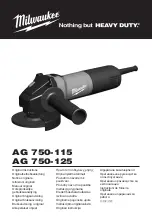
3
EllisSaw.com
1-800-383-5547
1. To remove the bearings, first remove the
contact wheel, Item 26, by loosening
the set screw with a 5/32 inch hex
key wrench. Refer to the parts catalog
illustration.
2. Next remove the socket head cap screw
and the adapter hex bolt, Items 19 & 21, and the
lock washers, Item 20, that secure Item 22 to Item 18.
Use a 5/16 inch hex key wrench. Set these aside for reas-
sembly.
3. Slide the bearing housing assembly out and place on a
work bench.
4. Loosen the set screw on each bearing collar, using a 1/8
inch hex key wrench.
5. Slide the spindle out of the bearing housing. You may
need to twist the collars and tap gently on the end of
the spindle.
6. Remove the old bearings with a punch or similar tool.
Tap the bearing out from the opposite end.
7. When replacing the new bearings use an arbor press or
tap the bearing into the housing with a hammer. Take
care not to damage the bearing. Press or tap only on the
outer ring of the bearing.
8. Slide the spindle into the bearings so that the end at the
rear of the housing is going to be flush with the bearing
collar. If the spindle does not fit, remove the burrs on
the spindle with a fine file.
9. Place the collars over the spindle and bearings. Rotate
each collar individually on its bearing in the direction
that the belt turns. That is, a counter-clockwise
rotation as you face the contact wheel end
of the spindle. Tighten the set screw us-
ing a 1/8 inch hex key wrench. Then
use a center punch and place it in the
countersunk hole on the collar. Tap
the punch lightly with a hammer so the
collar is “set” in the counter-clockwise motion. Repeat
with the other collar.
10. Replace the bearing housing assembly, Item 22.
a. Place the bearing housing assembly, Item 22,
into the Sliding Tube Assembly, Item 18, and line
up the threaded holes on Item 22 with the holes
in Item 18.
b. Place a lock washer, Item 20, over an adapter hex
bolt, Item 19. Insert the bolt, Item 19, into the
top hole in Item 18. Start the bolt into Item 22,
but only to depth of 1 or 2 threads. Repeat this
procedure for the bottom hole.
c. Turn the top bolt and bottom screw (Items 19
& 20), alternately, equal turns, until the lock
washers are compressed solid. Item 22 should be
centered within Item 18.
11. Replace contact wheel
Place contact wheel, Item 26, on the spindle with the
set screw side on the outside. Tighten the set screw
on the contact wheel hub, using a 5/16 inch hex
wrench.
• Use the grinder in a well ventilated area. The dust
created when grinding some materials can be
harmful. Dust masks are strongly recommended to
minimize dust inhalation.
• Sparks from the grinder could ignite flammable
materials and fumes. Keep these materials at a
safe distance from the grinder.
• Do not remove cover and guards on the machine
while doing grinding operations.
• Check that the drive and contact wheels are run-
ning true and are free of damage. Worn or dam-
aged parts should be replaced immediately.
• Check a new belt for nicks or cuts along its edge.
Do not use if damage is evident.
• Use extreme caution when grinding magnesium.
Magnesium dust can ignite. Have a bucket of sand
close by to extinguish a fire.
Hand Held Grinding
All grinding should be done below the centerline of the
contact wheel because it will be easier to hold the work and
minimize chatter. Present the workpiece to the contact wheel
in an upward motion to improve cutting and to draw the
hands away from the abrasive belt.
Platen Grinding
The platen is designed for grinding flat surfaces using light
pressure.
Tool Grinding
Use the tool rest, part # 7075, for accurate grinding such as
drill bits, chisels, etc.
Contact Wheel, Spindle and Bearing Replacement
GRINDING TECHNIQUES
WA R N I N G


























